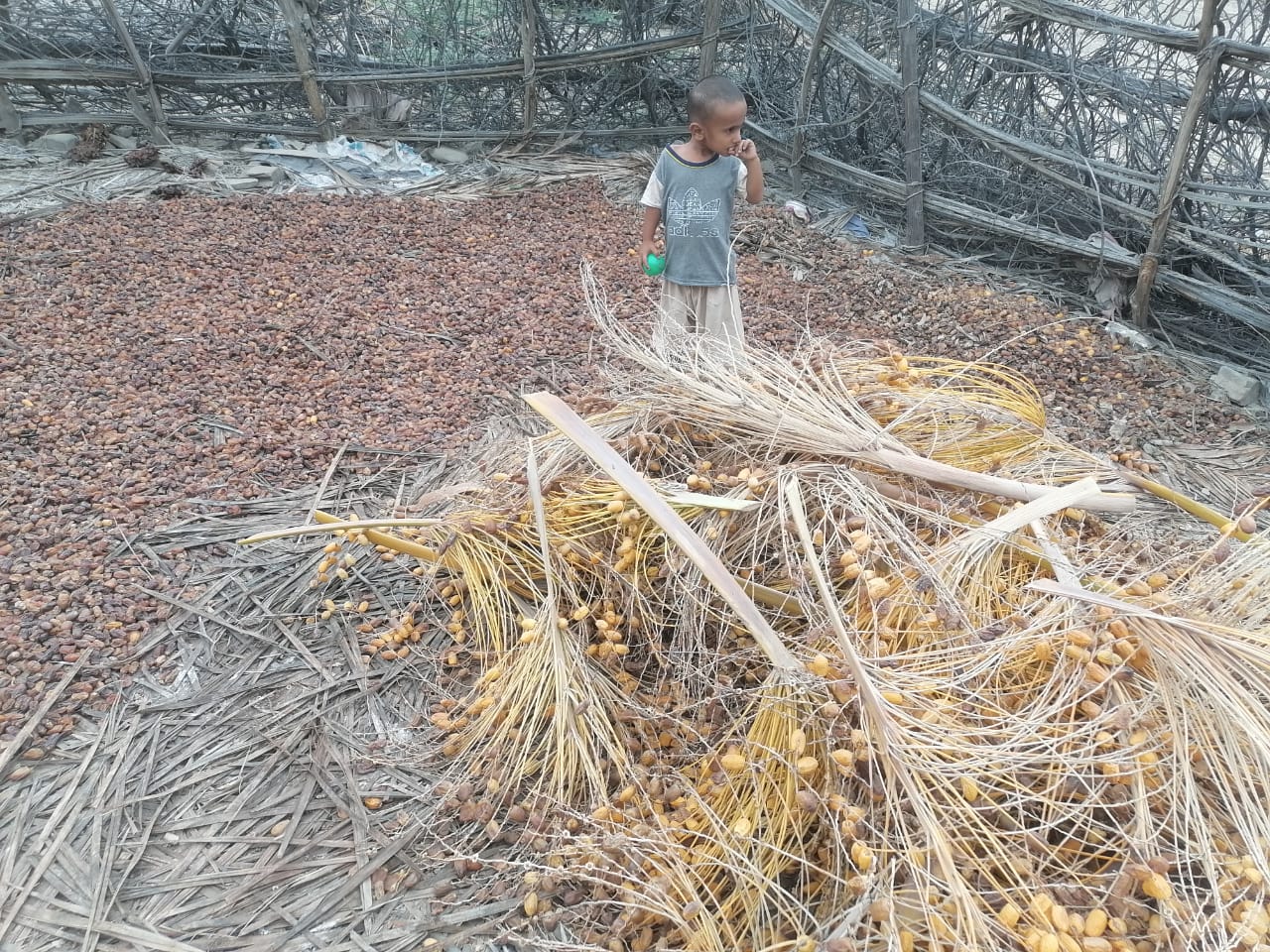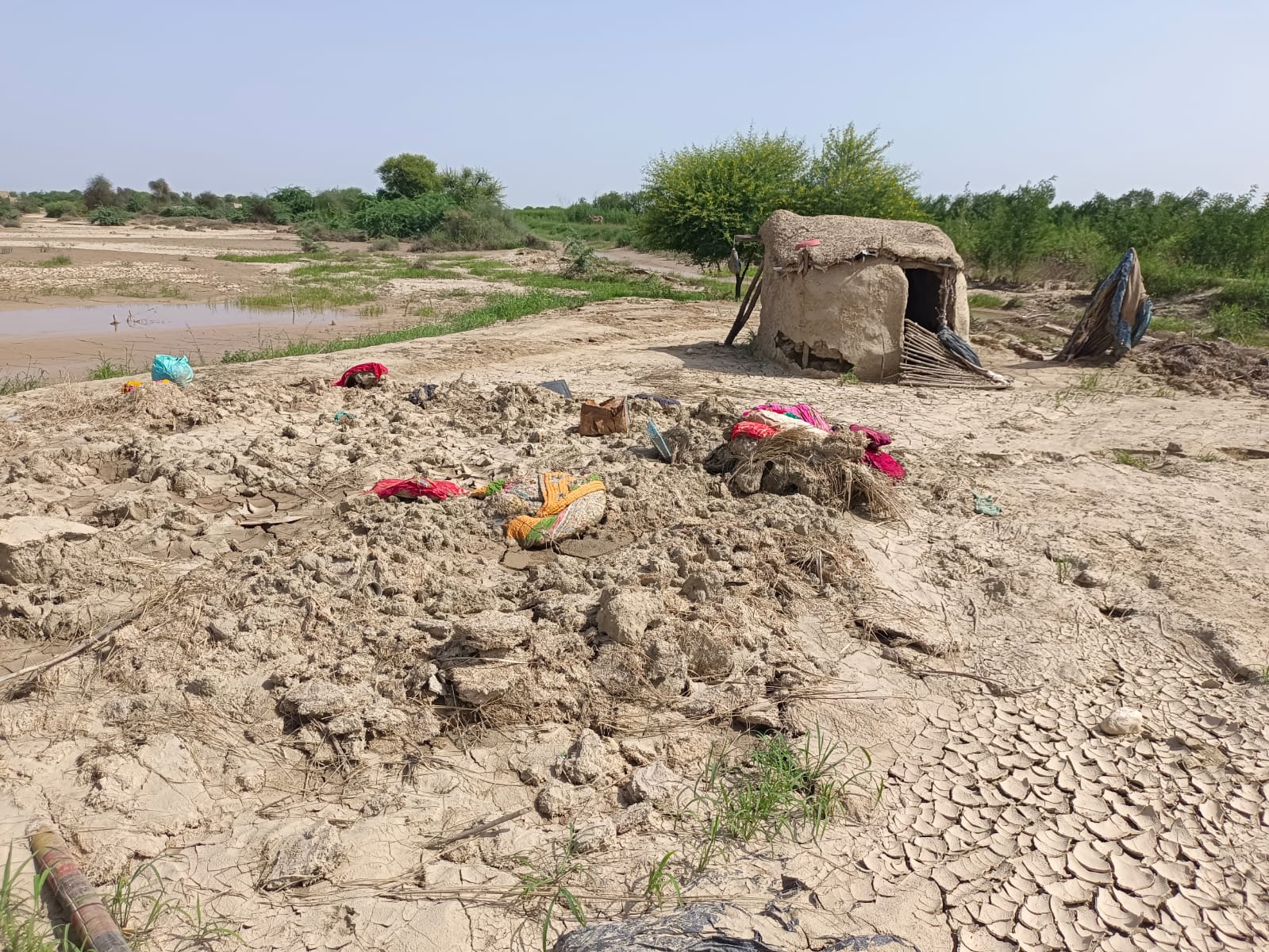Pakistan’s Climate Crisis : Unheard Ordeals Of Baluchistan’s Desperate Date Palm Farmers
Zareef Baloch
Quetta: Yar Mohammad Sakim, a 60-year-old farmer from Kech, is one of the victims of recent Monsoon flood devastations in Balochistan. Sakim’s date palm farms have been ruined which was his major source of income to sponsor his family members.
Standing near his home garden farm, Sakim told The PenPK.com that every year, he used to earn Rs500,000 to Rs600,000 from his home garden; but this year torrential rains and devastated floods have washed away everything. Sakim’s palm and date crops have been ruined, leaving him dependent on charity food and other stuff.

This year, the crop of date palm was much better than the previous years and there was a real possibility of doubling the profit, but unfortunately everything has washed away by the floods water, “My home garden had a potential of Rs500,000 to Rs600, 000 sale income.”
Sakim is not the only farmer in Kech district of Balochistan. There are thousands of other small farmers who have also have fallen victims to the recent floods.
According to farmer Sakim, “I have an alternative source of income but there are hundreds of farmers in Kech district whose only source of income is the date palm production.”

According to the Kech Agriculture Department, there are more than 500 varieties of date palm cultivated in Kech district and the recent floods have destroyed all of them. Around 16,000 registered in Kech district. There palm crops have been completely or substantially devastated by the recent floods.
Due to the torrential rains, there is a real possibility of losing 158,343 tons of dates. Nadil Shah, an official of the Kech Agriculture Department, told The PenPK.com that a total area of 24,827 acres of date farms has been affected with production capability of 158,343 tons. It is estimated that 18,885 acres of date crops have been devastated with an estimated loss of Rs4400 million, he informed.

Nadil Shah added, “No locally cultivated date will be available in markets in the month of Ramazan in Kech and surrounding areas this year. Cost would be high and may become out of reach of common people, therefore Iranian dates will occupy the market of Makran”.
Abdul Razzaq, a 50-year-old farmer from Panjgur, told this correspondent that his date and grapes palms have been badly damaged due to Monsoon flooding. He said that he has suffered losses of around Rs 500,000 which was a major source of his income for the entire year. Still, the loss of any farmer, including him, has not been redressed either by the provincial or the federal government, the Panjgur farmer lamented. According to Razzaq, although he has an alternative source of income as he is also involved in border trade, but he can understand the financial challenges faced by small farmers who are totally dependent on date palm production.

“Most of the farmers live on loans and pay off the debt by selling the palm crops to the market in the coming year. Many farmers have been forced to into other menial jobs,” Razzaq added.
Aamir Hussain, a 60-year-old farmer from Gishkaur, a village of Awaran district, told that the affected farmers didn’t receive even a penny from the government and other donor organisations. Hussain added that in his recent visit of Awaran, Baluchistan’s Chief Minister, Mir Abdul Qudoos Bizenjo has announced for rebuilding of farm land but yet no work is not being seen on the ground.
A livestock farmer Hussain said that livestock is his source of income but most of them have become vulnerable due to recent climate-induced flooding and animal disease outbreaks due to flood devastations. According to him, “My cotton crop has been completely ruined and I suffered losses of about Rs1million.” It is to mention here that Hussain is the sole breadwinner of a family. He doesn’t know how he would be able to manage his financial affairs.

According to Balochistan Rural Support Program (BRSP) as many as 417 villages have been destroyed in 15 districts and as many as 9,191 houses are partially damaged and 6,437 houses are completely damaged as a result of the recent flash floods. It is also mentioned that 98,208 households and 676,048 people have been affected. The BRSP revealed that 36 percent of agricultural lands have been damaged.
According to the climate risk index, Pakistan has been ranked among most vulnerable countries in the world since 2000.
According to the German watch institute (Global climate risk index 2021), Balochistan receives the least amount of rainfall each year. According to the National Disaster Management Authority (NDMA), the province has received 411 percent or more rain this year when compared with rain in the last 30 years.

Gwadar Development Authority (GDA) Deputy Director Environment Abdul Raheem Baloch said the recent floods in Balochistan are connected to the phenomenon of climate change. The general climate of Balochistan has standard features of drought and dryness. According to Deputy Director Baloch, the temperature has increased due to climate change. As the temperature rises the earth becomes dry and hard.
Abdul Raheem Baloch further said that indiscriminate cutting of trees makes the topsoil dry and hard. Forests are being cut down indiscriminately in Balochistan. Forests act as natural barriers against flooding and their destruction removes these safety valves.
Loss of Human & Livestock
Climate change, very much a 21st century phenomenon, is not only having economic impacts but also cultural, social and structural ones. According to many researchers, the recent floods in Pakistan are probably a result of climate change. Southern part of Punjab, entire Balochistan and some areas of Sindh rarely experience such incessant rain. However, climate change has altered the patterns of seasons. As a result, massive amounts of rain are falling, destroying people’s livelihood and increasing burden on the government reserves.
According to the NDMA report, more than 36,469 houses were destroyed all over Pakistan, with Balochistan accounting for 60 percent of the losses. Around 800 schools, 600 from Balochistan were affected due to Monsoon floods.
Around 3,000 schools across 26 districts of Balochistan have been ravaged as per the initial estimates. More than2.1 million animals have died, according to a local media report published on September, 15, 2022.
According to the Provincial Disaster Management Authority (PDMA), more than 200 people have died in the province. The floods have caused damage to more than 40,000 houses; of which 22,000 were destroyed. Around 7.1 million acres of crops across the province were lost. According to the official estimates the total loss incurred due to floods so far is 10 million USD.
Post-Disaster Needs
As stated in the report, it might take 2 to10 years of long-term construction of the areas affected by massive natural disaster. Moreover, Pakistan has seen a 5 percent upsurge in poverty, indicating that around 9 to 12 million people might fall below the poverty line.
In Balochistan, thousands of houses, roads, dams, bridges, embankments, and power lines have been damaged requiring a huge level of investment.
According to the Agriculture Expert Shabeer Sajidi, the climate-induced flooding is caused primarily by two key processes that also lead to change in the Monsoon Patterns.

He said that there is a drastic shortage of food items, limited availability of drinking water and partial breakdown of communication infrastructure.
Spread of diseases and widespread trauma from the devastation are also major challenges. Being the least developed province, Balochistan needs a comprehensive rehabilitation program.
Khaleel Ronjha, a social activist from Bela, who is currently engaged in relief work in Lasbela district of Balochistan, said that the recent flood destroyed everything in Lasbela.
Lasbela is one of the most affected districts of Balochistan in the current Monsoon rains and flash floods. Due to destruction of road network, governmental and non-governmental organisations have faced many difficulties to conduct relief operations.
Muhammad Moazzam Khan, The Technical Adviser (Marine Fisheries) of World Wild Fund (WWF) explained that due to climate change, weather patterns may change rapidly. “The temperature of the world is increasing due to this change; many regions across the world are expected to experience heavy rainfall and prolonged droughts,” he added.
Local Solutions
Muhammad Moazzam Khan suggested that the easy way to mitigate the impacts of climate change may be the construction of small dams for the restoration of rainwater. This will not only prevent urban flooding, but also increase agricultural production and generate job opportunities. He added that “Although climate change cannot be immediately controlled and floods cannot be stopped. The requirement is to modernise and upgrade the infrastructure to avoid the impacts of any natural disasters including heavy rainfall,”
According to Abdul Raheem Baloch, the development of holistic integrated climate change adaptation plans for all development sectors minimise the use of fossil fuels and encourage the mass transportation system for urban settlements, which would be helpful to prevent the province from flood devastation.

Baloch said afforestation of indigenous in rural and urban areas is crucial, adding that funds allocation for implementation of climate change adaptation plans in provincial and federal PSDP budgetary allocation is important.
He further added that climate and conservation initiative programs with local communities, and raising mass awareness programs on climate change and its affects on sectors of society are some other ways to mitigate the impacts of climate change in the country.
Zareef Baloch is a climate journalist based in Quetta. He can be contacted @ balochzareef088@gmail.com. All information and facts provided are the sole responsibility of the writer.

Comments are closed.